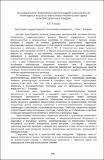Поиск по всему репозиторию:
Исследование комплексообразующей способности природных вод бассейна реки Припять методом флуоресцентных зондов

Открыть/скачать файлы документа
Автор
Дата издания
2004Издательство
АкадемияБиблиографическое описание
Головач, А. П. Исследование комплексообразующей способности природных вод бассейна реки Припять методом флуоресцентных зондов / А. П. Головач // Прыроднае асяроддзе Палесся: асаблівасці і перспектывы развіцця : матэрыялы міжнароднай навуковай канферэнцыі, Брэст, 16–18 чэрвеня 2004 г. : у 2 ч. / Нацыянальная акадэмія навук Беларусі, Адзел праблем Палесся ; рэдкал.: М. П. Ярчак [і інш.]. – Брэст : Академия, 2004. – Ч. 2. – С. 488–492.Аннотация на другом языке
The features of a hydrochemical mode of the river Pripyat are caused by the high contents humic substances. The application of a method offluorescent probes allows to make a conclusion, that on their surface there are two types of the connecting centres determining mechanisms of formation of complexes humic acids with anthropogenous polluting substances.
Higher constants of stability are inherent in complexes, which are formed as the connecting centres A. At increase of molecular weights offractions humic acids the stability of formed coordination units both such as A, and such as В is lowered. The quantity of the connecting centres such as В in all cases is more than those such as A. Total them grows with increase of molecular weights in a fraction and from fulvic acids to humic acids. It is possible to assume, that interaction humic substances with metals it will be more preferable to occur as the connecting centres A, as stability, having higher constant, and interaction to other substances - on more numerous, but forming less steady complexes, coordination units such as B.
URI документа
https://rep.bstu.by/handle/data/44308Документ расположен в коллекции

Это произведение доступно по лицензии Creative Commons «Attribution-NonCommercial» («Атрибуция-Некоммерчески») 4.0 Всемирная.